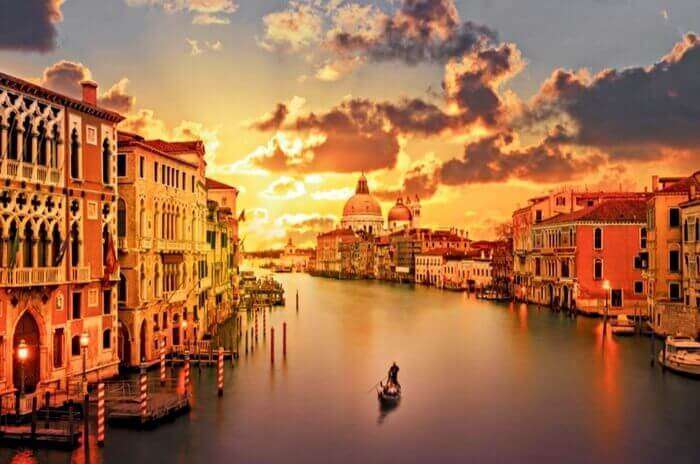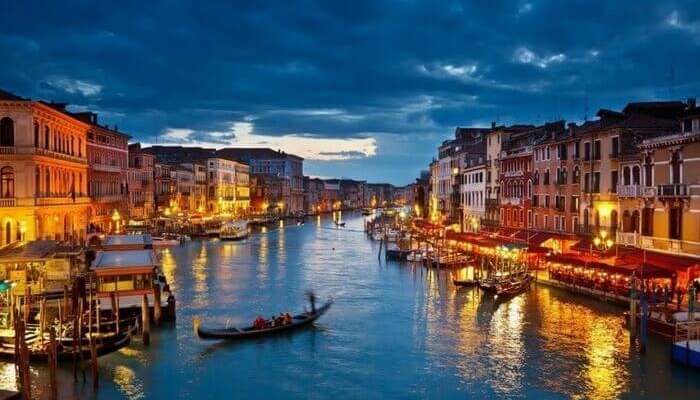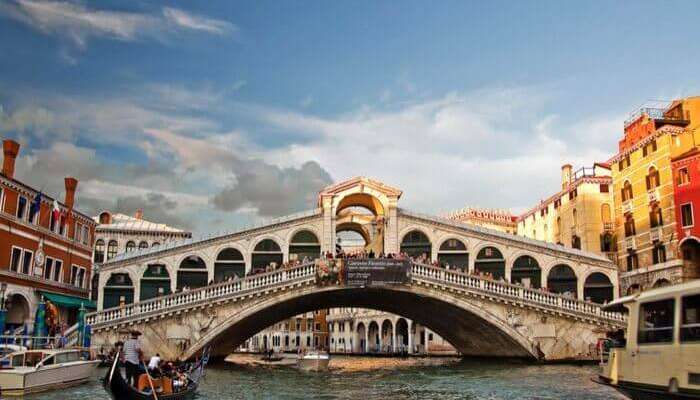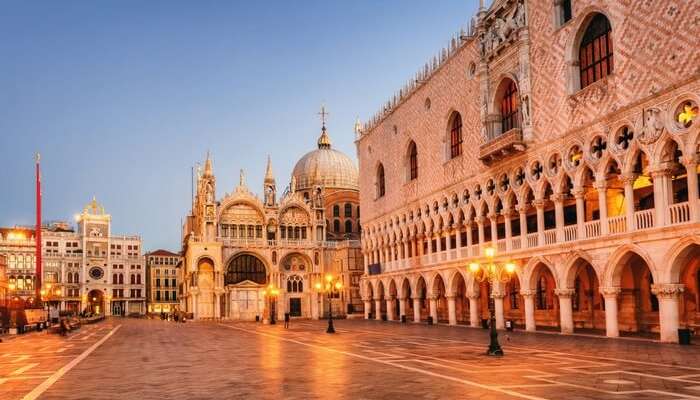

1. Grand Canal
Canal Grande or Grand Canal is the most important icon of Venice- lined with gorgeous and vibrant looking palaces and castles on both sides. The canal is one of the best places to visit in Venice and meanders through the city in a zigzag way with a few breathtaking bridges built over it. It is one of the most popular places to visit at Venice at night, to enjoy the stunning sunset and watch the sparkling water of the canal. Don’t Miss: Thrilling and romantic Gondola ride in the Grand Canals makes it one of the must-visit places to visit in Venice for a honeymoon. Also, enjoy the view of the Venetian Gothic and Early Renaissance facades of the palaces that come off the sides. Slightly more than 2 miles (3 km) long and between 100 and 225 feet (30 and 70 metres) wide, the Grand Canal has an average depth of 17 feet (5 metres) and connects at various points with a maze of smaller canals. These waterways carry the bulk of Venetian transportation, as automobiles are banned throughout much of the city. Traditional poled gondolas are a favourite with tourists but are now vastly outnumbered by motorized public-transit water buses (vaporetti) and private water taxis. Siren-equipped boats belonging to the police, fire, and emergency medical services traverse the Grand Canal at high speed, and barges are responsible for the delivery of goods throughout the city. The connection between Venetians and their city’s main thoroughfare does not end at the grave: funeral barges can be seen transporting the dead to Isola di San Michele, an island northeast of the city that has been the site of Venice’s largest cemetery since the early 19th century. The Grand Canal is lined on either side by palaces, churches, hotels, and other public buildings in Romanesque, Gothic, and Renaissance styles. Although comparatively few examples of earlier styles remain, a concerted effort has been made to preserve some of Venice’s more famous palaces. The Ca’ d’Oro, a 15th-century palace designed for Marino Contarini, of the eminent Contarini family, was extensively renovated in the late 20th century, and its ornate facade remains one of the Grand Canal’s most-arresting sights. The Palazzo Pesaro is a remarkable example of the Classical style. Completed in 1710, nearly three decades after the death of its chief designer, Baldassare Longhena, it now houses Venice’s International Gallery of Modern Art, as well as the Museum of Oriental Art.

2. Rialto Bridge

3. Doge’s Palace
Doge’s Palace was probably built between the 10th and 11th centuries on the basis of a fortified central core. This nucleus was constituted with a central body with towers in the corners forming one of the masterpieces of the Venetian Gothic. In the 12th century, the first restructuring was carried out with the duke Sebastiano Ziani, who transformed the fort into an elegant palace. Later in 1200 a new expansion was realized. Between 1339 and 1342 during the government of Bartolomeo Gradenigo, the palace began to obtain its present form. The doge Francesco Foscari extended the palace in 1424 towards the side of the Basilica of San Marco. In 1442 the architects Giovanni Bon and Bartolomeo Bon added the Porta della Carta. The inner part houses the apartments of the Doge and was built by the architect Antonio Rizzo after the fire of 1483. Throughout the 16th century there were several devastating fires alternating with restructuring and embellishments like the "Scala dei Giganti" (The Stairs of the Giants) and the creation of the main treasure: the Crucifixion of Tintoretto, painted to replace a damaged mural in one of the fires. At the beginning of the 17th century, the architect Antonio Contin added the "Prigioni Nuove" (New Prisons), beyond the canal connecting them to the Palace with the Bridge of Sighs, where the convicted went on their way to the new prison. In 1797, after the fall of the Republic of Venice, the Palace was conditioned to house the administrative offices. The prison, called "i Piombi" (the Leads) by the covering of the roof, retained their old function. After the annexation of Venice to the Kingdom of Italy, the palace underwent several restructurings until 1923 when it was destined to become one of the most important museums of Venice.

Great work❤
ReplyDelete